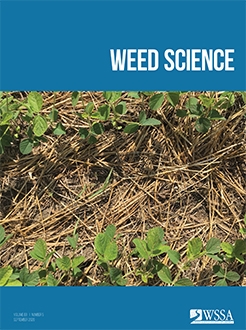Weedy rice (Oryza sativa f. spontanea Rosh.) is an emerging weed of California rice (Oryza sativa L.) that has potential to cause large yield losses. Early detection of weedy rice in the field is ideal to effectively control and prevent the spread of this weed. However, it is difficult to differentiate weedy rice from cultivated rice during early growth stages due to the close genetic and phenotypic relatedness of cultivated rice and weedy rice. The objective of this study is to examine phenotypic variation in weedy rice biotypes from California and to identify traits that could be used to visually identify weedy rice infestations at early growth stages for effective management. Greenhouse experiments were conducted in 2017 and 2018 using five phenotypically distinct biotypes of weedy rice found in California, along with diverse cultivated, weedy, and wild rice types in a randomized complete block design. We measured variation for 13 phenotypic traits associated with weedy rice and conducted principal component analysis and factor analysis to identify important weedy traits. Most weedy rice individuals within a biotype clustered together by phenotypic similarity. Pericarp color, hull color, chlorophyll content, grain length, plant height, leaf pubescence, collar color, and leaf sheath color account for most of the observed variation. California weedy rice biotypes are phenotypically distinct from wild rice and from weedy rice from the southern United States in their combinations of seed phenotypes and vegetative characteristics. In comparison with the locally grown temperate japonica cultivars, California weedy rice tends to be taller, with lower chlorophyll content and a red pericarp. Weedy rice biotypes vary in seed shattering and seed dormancy. For weedy rice management, plant height and chlorophyll content are distinct traits that could be used to differentiate weedy rice from the majority of cultivated rice varieties in California during vegetative stages of rice growth.
How to translate text using browser tools
2 June 2020
Phenotypic Diversity of Weedy Rice (Oryza sativa f. spontanea) Biotypes Found in California and Implications for Management
Elizabeth Karn,
Teresa De Leon,
Luis Espino,
Kassim Al-Khatib,
Whitney Brim-DeForest
ACCESS THE FULL ARTICLE

Weed Science
Vol. 68 • No. 5
September 2020
Vol. 68 • No. 5
September 2020
Early identification
factor analysis
red rice





